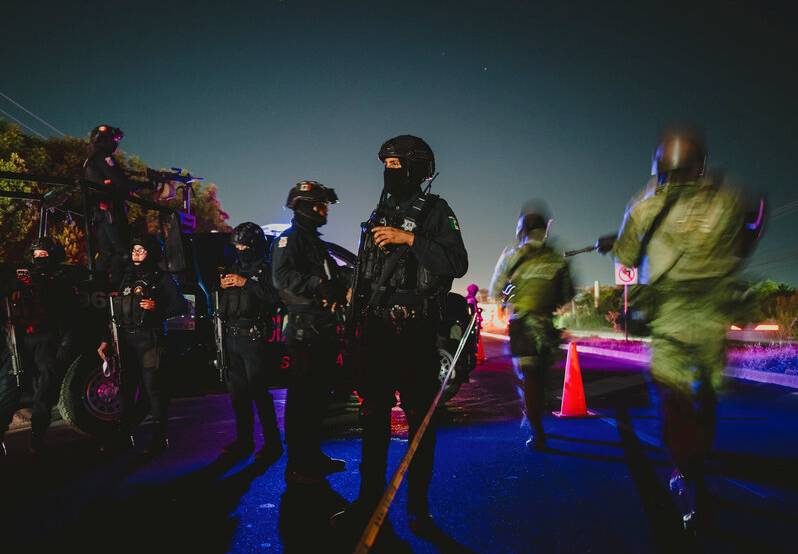Culiacán has been suffering for more than eight months from the violence generated by the internal dispute within the Sinaloa Cartel between the factions of La Chapiza and La Mayiza. The former, heirs of El Chapo Guzmán, carry the logo of a pizza slice; the latter, followers of El Mayo Zambada, use the image of a northern-style hat. The goal of both groups is to eliminate the other, which has pushed the Sinaloan capital into a state of “narco-pandemic”: the population refrains from leaving their homes and, if they do, they know they must return before sunset, since night is when the most violent clashes occur.
Faced with this uncertainty and terror, the constant question is: when will this situation end? Although difficult to answer, signs are emerging that the hat-wearing faction could take control of the capital.
Sinaloa, known as “Mexico’s breadbasket” because it is the country’s most important agricultural state, is also the place where poppy and marijuana cultivation in Mexico originated. As early as the 19th century, there were small crops in the mountains, but it was from the 1940s that production increased due to demand from the United States during World War II.
The birth of the Guadalajara Cartel in the 1980s changed the rules of the drug trafficking game. Its founders, Sinaloans Félix Gallardo, Caro Quintero, and Fonseca Carrillo, demonstrated that drug trafficking to the United States was a highly lucrative business that everyone wanted to be part of. Soon after, traffickers, criminal organizations, and armed wings began to appear, all while the Mexican state, due to complicity or incapacity, failed to confront the problem effectively.
In 2018, the arrival of Andrés Manuel López Obrador, from the Morena party, to the presidency promised a change in security policy. On the campaign trail, he claimed he would end violence by returning soldiers to their barracks and attacking the root causes that led people to commit crimes and join organized crime, thereby fostering peace and reconciliation among Mexicans.
However, the reality at the end of his six-year term was different: 199,952 homicides were recorded, surpassing Calderón’s 120,463 and Peña Nieto’s 156,066 (Vela, 2024). More than 50,000 people went missing during his term, and instead of soldiers returning to barracks, the military was assigned functions outside its usual competence. The National Guard was created under the command of the Army, and, according to Global Firepower (2025), Mexico now has 412,000 active soldiers, making it the country with the largest military in Latin America, surpassing Brazil and Colombia.
This scenario did not prevent Morena from sweeping the 2024 elections, leaving the opposition weakened. Just days after taking office, Claudia Sheinbaum presented the Mexican Government’s National Security Strategy, based on four pillars: addressing root causes, consolidating the National Guard, strengthening intelligence and investigation, and coordinating with state governments. This represents a continuation of her predecessor’s policies, though with a renewed discourse.
The Sinaloa Cartel has managed to survive PRI and PAN governments. Morena’s security policy has not weakened the organization: they have continued to operate as usual, and under Claudia Sheinbaum this trend seems likely to continue. The real threat, in fact, comes from the White House. Donald Trump has already designated Mexican cartels as terrorist organizations. Traffickers know that if captured and extradited to the United States, they face life imprisonment. The offensive is being waged both against the Mexican government, for failing to stop fentanyl trafficking, and against the cartels, responsible for its production and export.
The capture of El Mayo Zambada in the United States is what unleashed the violence in Culiacán and fractured the Sinaloa Cartel. An apparent betrayal by a relative of El Chapo facilitated El Mayo’s boarding of a plane that landed in Texas, where he was arrested. Immediately, both El Chapo’s heirs and El Mayo’s followers began fighting for control of the cartel. They now know that, if captured, they can be extradited to the United States and face life behind bars. With no way back, they have unleashed their entire arsenal.
During the eight months of clashes between La Chapiza and La Mayiza, it has been reported that El Chapo’s successors have suffered the most losses. In terms of priority targets, the pizza faction has taken the hardest hit: by March, federal forces had captured eleven of their operators, compared to only six from La Mayiza (Aispuro, 2025). Added to these arrests was a military operation earlier this year to capture Iván Archivaldo Guzmán, who, according to The Wall Street Journal, managed to escape through tunnels, just as his father once did.
In recent days, news that Ovidio Guzmán, another son of El Chapo, pleaded guilty to drug trafficking and agreed to cooperate with the U.S. government has dealt a heavy blow to the Chapitos. Mexico’s Secretary of Public Security, Omar García Harfuch, confirmed the departure of 17 of Ovidio’s relatives to the United States as part of the negotiation process between the trafficker and U.S. authorities.
The likely scenario is that the Chapitos’ group will be decimated by the capture of key figures, while Ovidio Guzmán’s statements to the U.S. government will affect the organization’s finances, production, and drug distribution points. In response, La Mayiza would launch offensives that could ultimately give them control of Culiacán and nearby towns.
This scenario would likely lead to another: with Culiacán under the control of the hat faction, the Chapitos’ men would move to other towns or cities, such as Los Mochis or Guasave, where they would encounter other cartels with significant strength, such as the latter. The drug-related violence would end in Culiacán but would spread to other regions of the state, mainly rural and agricultural areas. Since Sinaloa is Mexico’s main food producer, this could impact production and drive up prices.Historically, Mexico has been both a transit and production country for drugs, and Sinaloa, in particular, is one of the main producers of marijuana, poppy, and, in recent years, fentanyl. This reality has lasted for a century and will hardly change given U.S. demand and a Mexican state security policy that has not sought to eliminate the problem but merely contain it. The Sinaloa cartels resemble a hydra with a thousand heads: a virtual victory by La Mayiza in Culiacán would likely trigger the birth of new organizations.
*Machine translation, proofread by Ricardo Aceves.













